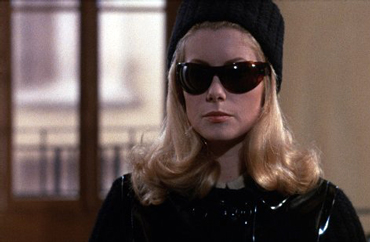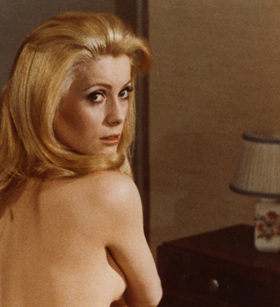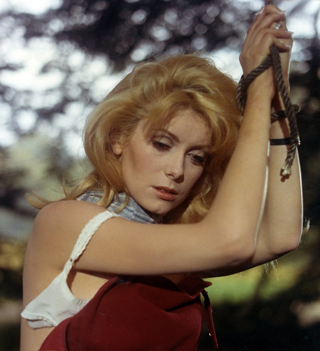
 |
|
|
|
Luis Buñuel is an amazing director in all respects, a true original. He's the most famous exponent of cinematic surrealism and a marvelous commentator on the contradictions of civilization's institutions, starting with the Church of Rome. Rarely direct in his political criticism, he undercuts hypocrisy and corruption with wit and panache; his critiques of the clergy are based in a deep understanding and fascination with theological studies. Buñuel was befriended by Salvador Dalí and then ruthlessly betrayed by him when in exile in New York. But instead of folding his tent, the tenacious artist-provocateur rebooted his career making movies in the normally very conservative Mexican film industry. After just one musical comedy (Gran Casino, 1947) he embarked on a wonderful series of comedies and melodramas that gleefully subverted bourgeois values. Good words to describe Buñuel's directing M.O. are teasing, malicious and wickedly funny: even when his story is serious, we are always aware of a motivating force that insists that all of life is a contradictory, ironic, cruel joke. 
Twenty years later and working back in France, Buñuel's Belle de Jour is a major production, in color and featuring a top new star, Catherine Deneuve of The Umbrellas of Cherbourg. It's an exception among Buñuel's late-career works, in that it isn't an outright absurdist comedy. The subject is sexual perversion, but Buñuel isn't making jokes or brandishing visual flourishes. The film's semi-surreal surface is completely serious. Said to be El Maestro's most commercially successful production, Belle de Jour's psycho-sexual mysteries are still being debated? How much of the film is a fantasy? Is it all happening in the head of a madwoman? Married for one year, Pierre and Séverine Serizy (Jean Sorel & Catherine Deneuve) are a model married couple: he's a successful doctor and she a pampered housewife with excellent taste in designer clothing. But something's very wrong. Séverine has not yet slept with her patient husband. She rejects his advances yet indulges in masochistic fantasies of being raped and abused. Her husband's friend, the predatory Henri Husson (Michel Piccoli) disturbs her by insisting that he's aware of her sexual undercurrents. To her own surprise, Séverine is fascinated when she hears that houses of prostitution still exist in Paris, and delivers herself to one run by the elegant Madame Anais (Geneviève Page of The Private Life of Sherlock Holmes). Taking the identity of "Belle de Jour", Séverine begins receiving clients between two and five in the afternoon. All goes well enough until she meets petty thief Marcel (Pierre Clémenti), a loose-cannon thief who falls in love with her. Séverine does nothing to avert disaster when Marcel declares that he wants her for his own. He doesn't care who's life is destroyed in the process. Then the rakish Husson visits the brothel, and learns the truth about Séverine's secret second life. Belle de Jour shows Luis Buñuel as a master of cinematic control. The film isn't a showcase of surreal events but rather a subtle expression of a surreal world view. In the 1960s art film fans were still trying to "decode" Fellini, Bergman and Antonioni pictures with approaches taken from literature and poetry studies -- looking for themes, symbols, references. Buñuel confounds this kind of analysis. The big stumbling block is separating 'reality' from 'fantasy', an ambition that doesn't get at the heart of the picture. In a true surrealist work (in terms of 1920s definitions) there is no clean divider between what is really happening and what is a product of the mind. Buñuel only lets us think there is a scheme to be detected. The first obvious fantasy places Séverine in a sexual scenario where her spiteful husbands orders his coachmen to strip, whip, and rape her. As it's the first scene in the movie, we don't know what's going on. But in the middle of her distress, Séverine suddenly comes up with a question that could be coming from a dreamer speaking from the middle of a dream too pleasant to be interrupted: "Pierre, please, don't let the cats out." 
No easy interpretation arises. The carriage bells from the first fantasy signal some of the return fantasies, but not all of them. The carriage and the coachmen return in a bizarre scene that some may think is a real occurrence. Séverine is accosted by a middle-aged Duke (Georges Marchal), who hires her to pretend to be the corpse of his long-dead daughter. In what plays as a curious revisit of The Horrible Dr. Hichcock, Séverine dons a diaphanous nightgown and pretends to be dead while the Count enacts his personal sexual fantasy. The film's conclusion confounds most viewers -- when a certain character suddenly revives, theater audiences often react in amused frustration: "Oh, nothing makes sense in this show." Buñuel may be indulging in Dada for its own sake, but it's more likely that he's working a personal, intellectual interpretation of his own. All the characters seem bound by their personal prisons of sexual comfort zones. The virtuous, understanding, passive husband admits to visiting prostitutes, and adds that he was always depressed for the rest of the day. Does he enjoy being a matrimonial martyr to his wife's frigidity. Anais is directly attracted to Séverine, who accepts the compliment of her boss'es devotion. The repulsive thug Marcel is confected to seem the opposite of anything that might attract Séverine. But she apparently goes for his ugly steel teeth, unkempt appearance and insulting manners. The Asian client's mysterious Thing in the Box repels the other girls, but fascinates her; as far as we're concerned, we'll choose the mystery bug (?) over Marcel. Molested as a child, knowing shame but not guilt, Séverine seems attracted to perverse self-humiliation. Yet she sees one client's need to be humiliated as demeaning and sick. The unpleasant Marcel shows little regard for anything but his own momentary desires, and even abandons his partner in crime, Hyppolite (Francisco Rabal). But for all intents and purposes Henri Husson might as well be The Devil. His interest in ravishing Séverine wanes as soon as he discovers that she's "impure"; yet he intervenes to commit a horribly cruel and destructive final act, with the wretched excuse that he's actually doing a friend a favor. Strangely (and indicating an entirely non-random rationale behind Buñuel's story details), Séverine does nothing to stop Husson. Is he part of her overarching fantasy, the comeuppance-punishment she so seems to desire? We're told that Buñuel didn't initially want the icy beauty Catherine Deneuve to play Séverine, but she's an ideal choice. We don't watch the truly erotic Belle de Jour as we would any other movie about "sex" -- we don't wait impatiently for the leading lady to be ravaged, especially after Buñuel's elegant first scene. Deneuve's beauty is positively intimidating, and her ability to withhold her emotions behind a mask of beauty makes us eager to learn what the hell she is thinking from moment to moment. We're shocked when she fantasizes scenes of humiliation and degradation (as mild as they are by today's standard). But her rebellion against bourgeois values makes her a real surreal heroine. Does she find peace at the end, or only a convenient harmony, having a husband that she doesn't have to make excuses to avoid sex? 
I don't claim anything like a full understanding of Buñuel but count myself as an enthusiastic fan. Belle de Jour cleverly sidesteps attempt to nail down the exact nature of every scene. In the necrophiliac sequence at the Duke's villa, Séverine pauses to peek over the edge of her coffin, to see just what the **** the Duke is doing by himself on the floor. If this is her sex fantasy, why is she introducing a comedic element? And Buñuel is sufficiently mischievous to purposely toss in crazy clues to lead us in the wrong direction. The "let the cats out" line from the whipping fantasy gets a replay later in the show. Passing time with her colleagues at the brothel, Séverine comes up with an answer for a crossword puzzle: "Aeneas". That sounds suspiciously like "Anais", the Madam's name. Is Séverine idly toying with her invented reality? Some interpreters of Belle de Jour take the easy path and characterize everything we see as a fantasy inside a daydream inside a deceptively "real" waking reality. And surrealists would say there is no difference at all between those domains. 1 Criterion's Blu-ray of Belle de Jour is a gorgeous encoding of this beautiful production, which I think is Luis Buñuel's third production in color. Cameraman Sascha Vierny creates lovely images in the Parisian light, which is so soft that people barely throw shadows on the ground. Ms. Deneuve looks simply exquisite without elaborate lighting or expressionist effects. Buñuel's direction has reached a point where he keeps things simple and direct, with no tricks, no fancy opticals or cutting patterns. We think of Buñuel as a maker of marvelous, unique films. There's just nobody like him. Criterion's extras cover all bases with this key picture of 1967. Michael Wood contributes a full audio commentary, and an interesting video essay brings together the analysis of Susie Bright and Linda Williams. Another new item is an interview with Jean-Claude Carrière. A 1967 French TV excerpt is present, along with a pair of trailers. The fat insert booklet contains a essay by Melissa Anderson and a reprint of an interview with Buñuel.
On a scale of Excellent, Good, Fair, and Poor,
Belle de Jour Blu-ray rates:
Footnote:
1. I personally like the mental-intellectual games of surrealism, even as real understanding (as with most philosophical investigations) sails over my head. But my reality is entirely distinguishable from my daydreams and my fantasies. Other people exist, and their complexities need to be taken into account. And in my imagination I never get hungry ... which happens with a nagging regularity in the banal "real" world.
Reviews on the Savant main site have additional credits information and are often updated and annotated with reader input and graphics. Also, don't forget the 2011 Savant Wish List. T'was Ever Thus.
Review Staff | About DVD Talk | Newsletter Subscribe | Join DVD Talk Forum |
| ||||||||||||||||||